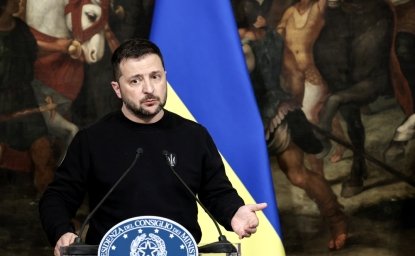
A blog of the Kennan Institute
War frequently leads people to imagine what will come once peace arrives. How can we visualize what will follow? How can we think about making that envisioned future real? Such questions run through art created at a time of war even as such creativity often focuses on the human catastrophe that war generates. This juxtaposition of horror and disgust for the reality of the present with the hope that all will be better once the fighting ends commands a leap of imagination.
Kyiv Modern-Ballet Theater’s inspirational choreographer Radu Poklitar has observed that he creates his own world because he can’t do anything else. The worlds he and his company build on the stage help them and their audiences confront the devastation of war and dream of a future that will arrive with peace. As noted in previous blog posts (see April 8, 2022, July 21, 2023, and January 19, 2024), the Moldova-born, Moscow- and Odesa-trained Poklitar and his company have steadfastly performed throughout the war. They have drawn on their commitment to expressive modern dance in order to explore some of the most emotional challenges confronting war-torn Ukraine.
An evening of two one-act ballets in May explicitly explored the necessity of Ukrainians deciding for themselves the future they want to embrace. Both works served as allegories about the values of democratic society.
The program began with Discrimination, a new work set to the music of George Frideric Handel and contemporary Ukrainian composer Valentyn Sylvestrov. The ballet presents a series of parables depicting various forms of discrimination. The seemingly nonlinear piece slowly reveals the emotions that lead to disagreement and prejudice. Expressions of tolerance and mutual understanding performed through dance ultimately reveal the values of a democratic society that rise above difference. The choreography’s continuous movements amplify the preeminence of democratic values for the Ukrainian future.
Poklitar set Tomorrow, the evening’s second work, to the music of Frédéric Chopin. Performed on a bare, semi-lit stage, the dancers perform in costumes casting the colors of flickering flames, representing the divine energy within every human being. Kinetic physicality tells stories of quotidian travails. Chopin’s music creates an ethereal harmony that contrasts with the rhythms of modern life. Present-day troubles diminish in significance as dance turns to a future in which such concerns no longer matter. As one reviewer noted after the work’s March 2023 premier, this is a show emphasizing that Russia is the past and Ukraine is the future.
Staged at the October Palace, the performance’s venue has its own history of joys and horrors. Architect Vikentiy Beretti designed the neo-classical palace as the Kyiv Institute for Noble Maidens during the 1830s and 1840s. The Soviet Cheka (predecessor to the KGB) claimed the building as its headquarters following the Bolshevik revolution. Cheka officers killed about 120,000 in the building before it was destroyed by German bombs during World War II. Renovated during the 1950s as a concert hall, the building has been an important performance setting ever since. Its history symbolizes fate’s twists and turns, especially in Ukraine and Kyiv.
Poklitar envisions the Kyiv Modern-Dance Theater as a creative space for movement that offers bold experimentation together with original readings of world-famous ballets. Over the course of the war, he has fostered a laboratory on stage, one that empowers his audiences to consider what their—and Ukraine’s—future might be. The imaginary worlds he and his company create through dance enable futures that are Ukrainian no matter how Russian they may have been in the past.
The opinions expressed in this article are those solely of the author and do not reflect the views of the Kennan Institute.
Author

Former Wilson Center Vice President for Programs (2014-2017); Director of the Comparative Urban Studies Program/Urban Sustainability Laboratory (1992-2017); Director of the Kennan Institute for Advanced Russian Studies (1989-2012) and Director of the Program on Global Sustainability and Resilience (2012-2014)

Kennan Institute
The Kennan Institute is the premier US center for advanced research on Eurasia and the oldest and largest regional program at the Woodrow Wilson International Center for Scholars. The Kennan Institute is committed to improving American understanding of Russia, Ukraine, Central Asia, the South Caucasus, and the surrounding region though research and exchange. Read more

Explore More in Focus Ukraine
Browse Focus Ukraine
Building a Thriving Ukrainian Design Community Now

Ukraine Seeks to End the War. What's Wrong With the “Peace Scenarios”?


